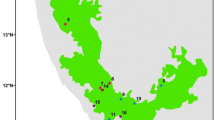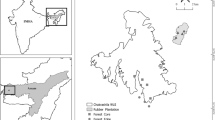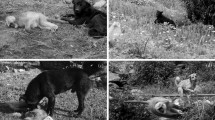Abstract
The social organization of hanuman langurs (Presbytis entellus;Colobinae) was studied in Kanha Tiger Reserve, Central Indian Highlands, for 2300 hr (1980–1985), in a mosaic of moist deciduous forest and anthropogenic meadow. The langur population density was 46.15/km2 and the mean troop and band sizes were 21.7 and 14.0, respectively. Of 14 troops, 13 were one-male and 1 was trimale. The population adult sex ratio was 1:2.5. The majority of female sexual solicitations was directed toward the harem male. The birth season was December to May, with an estimated gestation of 171–224 days. A review of langur reproductive seasonality suggests that breeding throughout the year is confined to those populations able to exploit human food sources. Mortality during the first year of life was 40%, including infanticide. A significant positive correlation was found between the age of an infant at death or disappearance and the mother’s subsequent interbirth interval. Five cases of social change are described, including female transfer, one-male to multimale change, troop formation, and gradual and rapid replacement of troop males. Takeover-associated infant killing by band males, in an undisturbed moderate-density population, supported the sexual-selection/infanticide hypothesis but not the social-pathology hypothesis. However, it could not be directly confirmed that an invading infanticidal male gains a reproductive advantage. The male tenure of harems was estimated to be 45 months.
Similar content being viewed by others
References
Agoramoorthy, G. (1986). Recent observations on 12 cases of infanticide in hanuman langurs,Presbytis entellus, around Jodhpur, India.Primate Rep. 14: 209–210.
Altmann, J., Altmann, S. A., and Hausfater, G. (1978). Primate infant’s effects on mother’s future reproduction.Science 201: 1028–1029.
Bishop, N. H. (1979). Himalayan langurs: Temperate colobines.J. Hum. Evol. 8: 251–281.
Bishop, N. H., Hrdy, S. B., Teas, J., and Moore, J. (1981). Measures of human influences in habitats of South Asian monkeys.Int. J. Primatol. 2: 153–167.
Boggess, J. (1979). Troop male membership changes and infant killing in langurs (Presbytis entellus).Folia primatol. 32: 65–107.
Boggess, J. (1980). Intermale relations and troop-male membership changes in langurs (Presbytis entellus) in Nepal.Int. J. Primatol. 1: 233–273.
Boggess, J. (1984). Infant killing and male reproductive strategies in langurs (Presbytis entellus). In Hausfater, G., and Hrdy, S. B. (eds.),Infanticide: Comparative and Evolutionary Perspectives, Aldine, New York, pp. 283–310.
Brander, A. A. D. (1906).Working Plan for the Forests of the Banjar Valley Reserve, Mandla Forest Division, Northern Circle, C.P., for the Period 1904-1935, Pioneer Press, Allahabad.
Bruce, H. M. (1960). A block to pregnancy in the house mouse caused by the proximity of strange males.J. Reprod. Fert. 1: 96–103.
Butynski, T. M. (1982). Harem male replacement and infanticide in the blue money (Cercopithecus mil is stuhlmanni) in the Kibale Forest, Uganda.Am. J. Primatol. 3: 1–22.
Calhoun, J. B. (1962). Population density and social pathology.Sci. Am. 206: 139–148.
Chalmers, N. (1979).Social Behaviour in Primates, Arnold, London.
Chapman, M., and Hausfater, G. (1980). The reproductive consequences of infanticide in langurs: A mathematical model.Behav. Ecol. Sociobiol. 5: 227–240.
Chism, J. B., and Rowell, T. E. (1986). Mating and residence patterns of male patas monkeys.Ethology 72: 31–39.
Collins, D. A., Busse, C. D., and Goodall, J. (1984). Infanticide in two populations of savanna baboons. In Hausfater, G., and Hrdy, S. B. (eds.),Infanticide: Comparative and Evolutionary Perspectives, Aldine, New York, pp. 193–215.
Cords, M. (1984). Mating patterns and social structure in redtailed monkeys (Cercopithecus ascanius).Z. Tierpsychol. 64: 313–329.
Crockett, C. M., and Sekulic, R. (1984). Infanticide in red howler monkeys (Alouatta seniculus). In Hausfater, G., and Hrdy, S. B. (eds.),Infanticide: Comparative and Evolutionary Perspectives, Aldine, New York, pp. 173–191.
Curtin, R. A. (1977). Langur social behavior and infant mortality.Kroeber Anthropol. Soc. Papers 50: 27–36.
Curtin, R. A., and Dolhinow, P. (1978). Primate social behavior in a changing world.Am. Sci. 66: 468–475.
Dawkins, R., and Carlisle, J. R. (1976). Parental investment, mate desertion and a fallacy.Nature (London) 262: 131–132.
Dolhinow, P. (1972). The north Indian langur. In Dolhinow, P. (ed.),Primate Patterns, Holt, Rinehart and Winston, New York, pp. 181–238.
Dunbar, R. I. M. (1984).Reproductive Decisions: An Economic Analysis of Gelada Baboon Social Strategies, Princeton University Press, Princeton, N.J.
Dunbar, R. I. M., and Dunbar, E. P. (1976). Constraints on social structure among black-and-white colobus monkey groups.Anim. Behav. 24: 84–92.
Eisenberg, J. F., Muckenhirn, N. A., and Rudran, R. (1972). The relation between ecology and social structure in primates.Science 176: 863–874.
Elwin, V. (1939).The Baiga, John Murray, London.
Emlen, S., and Oring, L. (1977). Ecology, sexual selection and the evolution of mating systems.Science 197: 215–225.
Forsyth, J. (1872).The Highlands of Central India, Chapman and Hall, London.
Hamilton, W. D. (1964). The genetical theory of social behavior.J. Theor. Biol. 7: 1–52.
Harley, D. (1985). Birth spacing in langur monkeys (Presbytis entellus).Int. J. Primatol. 6: 227–242.
Hausfater, G., and Hrdy, S. B. (1984).Infanticide: Comparative and Evolutionary Perspectives, Aldine, New York.
Hausfater, G., Aref, S., and Cairns, S. J. (1982). Infanticide as an alternative male reproductive strategy in langurs: A mathematical model.J. Theor. Biol. 94: 391–412.
Hrdy, S. B. (1974). Male-male competition and infanticide among langurs (Presbytis entellus) of Abu, Rajasthan.Folia primatol. 22: 19–58.
Hrdy, S. B., (1977).The langurs of Abu: Female and Male Strategies of Reproduction, Harvard University Press, Cambridge, Mass.
Hrdy, S. B. (1979). Infanticide among animals: A review, classification and examination of the implications for the reproductive strategies of females.Ethol. Sociobiol. 1: 13–40.
Hrdy, S. B. (1982). Positivist thinking encounters field primatology, resulting in agonistic behavior.Soc. Sci. Inform. 21: 245–250.
Kankane, P. L. (1980). Studies on the hanuman langur (Presbytis entellus (Dufresne)) at Kanha National Park, M.P.Proc. Wildlife Workshop, Dehra Dun, pp. 61–71.
Lancaster, J. B., and Lee, R. B. (1965). The annual reproductive cycle in monkeys and apes. In Devore, I. (ed.),Primate Behavior, Holt, Rinehart and Winston, New York, pp. 486–513.
Laws, J. W., and Vonder Haar Laws, J. (1984). Social interactions among adult male langurs (Presbytis entellus) at Rajaji Wildlife Sanctary.Int. J. Primatol. 5: 31–50.
Leland, L., Struhsaker, T. T., and Butynski, T. M. (1984). Infanticide by adult males in three primate species of the Kibale Forest, Uganda: A test of hypotheses. In Hausfater, G., and Hrdy, S. B. (eds.),Infanticide: Comparative and Evolutionary Perspectives, Aldine, New York, pp. 151–172.
Makwana, S. C. (1979). Infanticide and social change in two groups of the hanuman langur,Presbytis entellus, at Jodhpur.Primates 20: 293–300.
Makwana, S. C., and Advani, R. (1981). Social changes in the hanuman langurPresbytis entellus around Jodhpur, India.J. Bombay Nat. Hist. Soc. 78: 152–154.
Marsh, C. W. (1979). Comparative aspects of social organisation in the Tana River red colobus,Colobus badius rufomitratus.Z. Tierpsychol. 51: 337–362.
McCann, C. (1933). Observations on some of the Indian langurs.J. Bombay Nat. Hist. Soc. 36: 616–628.
Mehta, J. (1965).Working Plan for Mandla Division 1949-50 to 1963-64, Forest Department, Madhya Pradesh.
Mohnot, S. M. (1971). Some aspects of social changes and infant-killing in the hanuman langur,Presbytis entellus (Primates: Cercopithecidae) in Western India.Mammalia 35: 175–198.
Mohnot, S. M. (1978). Peripheralisation of weaned male juveniles inPresbytis entellus. In Chivers, D. J., and Herbert, J. (eds.),Recent Advances in Primatology, Academic Press, London, Vol. I, pp. 87–91.
Mohnot, S. M. (1980). Inter-group infant kidnapping in hanuman langur,Presbytis entellus. Folia primatol. 34: 259–277.
Mohnot, S. M., Agoramoorthy, G., and Rajpurohit, L. S. (1986). Male take-overs inducing abortions in hanuman langurs (Presbytis entellus).Primate Rep. 14: 208.
Moore, J. (1984). Female transfer in primates.Int. J. Primatol. 5: 537–589.
Moore, J. (1985).Demography and Sociology in Primates, Ph.D. thesis. Harvard University, Cambridge, Mass.
Moore, J. (1986). Paternity in all-male groups of langurs (Presbytis entellus).Primate Rep. 14: 30–31.
Moore, J., and Ali, R. (1984). Are dispersal and inbreeding avoidance related?Anim. Behav. 32: 94–112.
Napier, J. R., and Napier, P. H. (1967).A Handbook of Living Primates, Academic Press, New York.
Nagel, U., and Lohri, F. (1973). Die Languren der Kanha-Wiesen.Vierteljahrssch. naturforsch. Gesellschaft Zurich 118: 71–85.
Newton, P. N. (1984a).The Ecology and Social Organisation of Hanuman Langurs (Presbytis entellus,Dufresne 1797) in Kanha Tiger Reserve, Central Indian Highlands, D.Phil, thesis, University of Oxford.
Newton, P. N. (1984b). Forest langurs.Sanctuary/Asia 4(4): 334–343.
Newton, P. N. (1985). The behavioural ecology of forest hanuman langurs.Tigerpaper 12: 3–7.
Newton, P. N. (1986). Infanticide in an undisturbed forest population of hanuman langurs,Presbytis entellus. Anim. Behav. 34: 785–789.
Newton, P. N. (1987). The variable social organisation of hanuman langurs (Presbytis entellus), infanticide, and the monopolization of females (submitted for publication).
Oppenheimer, J. R. (1976).Presbytis entellus: Birth in a free-ranging primate troop.Primates 17: 541–542.
Oppenheimer, J. R. (1977).Presbytis entellus, the hanuman langur. In Rainier, H. S. H., and Bourne, G. H. (eds.),Primate Conservation, Academic Press, New York, pp. 469–512.
Panwar, H. S. (no date). Management Plan for Kanha Tiger Reserve, Madhya Pradesh, 1973-4 to 1978-9, Mimeo, Madhya Pradesh Forest Department.
Parthasarathy, M. D., and Rahman, H. (1974). Infant killing and dominance assertion among the hanuman langur.Abstr. 5th Int. Congr. Int. Primatol. Soc., Nagoya, Japan, p. 35.
Prakash, I. (1962). Group organization, sexual behaviour and breeding season of certain Indian monkeys.Jap. J. Ecol. 12: 83–86.
Rajpurohit, L. S., Mohnot, S. M., Agoramoorthy, G., and Srivastava, A. (1986). Observations on ousted alpha males of bisexual groups of hanuman langurs (Presbytis entellus).Primate Rep. 14: 209.
Ripley, S. (1980). Infanticide in langurs and man: Adaptive advantage or social pathology? In Cohen, M. N., Malpass, R. S., and Klein, H. G. (eds.),Biosocial Mechanisms of Population Regulation, Yale University Press, New Haven, Conn., pp. 349–390.
Roonwal, M. L., and Mohnot, S. M. (1977).Primates of South Asia: Ecology, Sociobiology and Behavior, Harvard University Press, Cambridge, Mass.
Rudran, R. (1973). Adult male replacement in one-male troops of purple-faced langurs (Presbytis senex senex) and its effect on population structure.Folia primatol. 19: 166–192.
Schaller, G. B. (1967).The Deer and the Tiger, Chicago University Press, Chicago.
Schubert, G. (1982). Infanticide by usurper hanuman langur males: A sociobiological myth.Soc. Sci. Inform. 21: 199–244.
Siegel, S. (1956).Nonparametric Statistics for the Behavioral Sciences, McGraw-Hill Kogakusha, Tokyo.
Sommer, V. (1986). Adult male replacement in troops of free-ranging langurs (Presbytis entellus) around Jodhpur, India.Primate Rep. 14: 208–209.
Sommer, V., and Mohnot, S. M. (1985). New observations of infanticides among hanuman langurs (Presbytis entellus) near Jodhpur (Rajasthan/India).Behav. Ecol. Sociobiol. 16: 245–248.
Struhsaker, T. T. (1969). Correlates of ecology and social organisation among African cercopithecines.Folia primatol. 11:80–118.
Struhsaker, T. T. (1977). Infanticide and social organisation in the redtail monkey (Cercopithecus ascanius schmidti) in the Kibale Forest, Uganda.Z. Tierpsychol. 45: 75–84.
Struhsaker, T. T., and Leland, L. (1979). Socioecology of five sympatric monkey species in the Kibale Forest, Uganda. In Rosenblatt, J., Hinde, R. A., Shaw, E., and Beer, C. (eds.),Advances in the Study of Behaviour, Vol. 9, Academic Press, New York, pp. 159–227.
Sugiyama, Y. (1964). Group composition, population density and some sociological observations of hanuman langurs (Presbytis entellus).Primates 5: 7–38.
Sugiyama, Y. (1965). On the social change of hanuman langurs (Presbytis entellus) in their natural conditions.Primates 6: 381–417.
Sugiyama, Y. (1967). Social organization of hanuman langurs. In Altmann, S. (ed.),Social Communication Among Primates, Chicago University Press, Chicago, pp. 221–236.
Sugiyama, Y. (1976). Characteristics of the ecology of the Himalayan langurs.J. hum. Evol. 5: 249–277.
Sugiyama, Y., Yoshiba, K., and Parthasarathy, M. D. (1965). Home range, mating season, male group and intertroop relations of hanuman langurs (Presbytis entellus).Primates 6: 73–106.
Trivers, R. L. (1972). Parental investments and sexual selection. In Campbell, B. (ed.),Sexual Selection and the Descent of Man, Chicago University Press, Chicago, pp. 136–179.
Tsingalia, H. M., and Rowell, T. E. (1984). The behaviour of adult male blue monkeys.Z. Tierpsychol. 64: 253–268.
van Schaik, C. P., and van Hooff, J. A. R. A. M. (1983). On the ultimate causes of primate social systems.Behaviour 85: 91–117.
Vogel, C. (1977). Ecology and sociology ofPresbytis entellus. In Prasad, M. R. N., and Kumar, T. C. A. (eds.),Use of Non-human Primates in Biomedical Research, Indian National Science Academy, Delhi, pp. 24–45.
Vogel, C. (1979). Der Hanuman-Langur (Presbytis entellus), ein Parade-Exempel für die theoretischen Konzepte der “Soriobiologie”?Verh. Dtsch. Zool. Ges. 72: 73–89.
Vogel, C., and Loch, H. (1984). Reproductive parameters, adult male replacements and infanticide among free ranging langurs (Presbytis entellus) at Jodhpur, India. In Hausfater, G., and Hrdy, S. B. (eds.),Infanticide: Comparative and Evolutionary Perspectives, Aldine Press, New York, pp. 237–255.
Whitten, P. L. (1982).Female Reproductive Strategies Among Vervet Monkeys, Ph.D. thesis, Harvard University, Cambridge, Mass.
Winkler, P., Loch, H., and Vogel, C. (1984). Life history of hanuman langurs (Presbytis entellus).Folia primatol. 43: 1–23.
Wittenberger, J. F. (1980). Group size and polygyny in social mammals.Am. Nat. 115:197–222.
Wolfheim, J. H. (1983).Primates of the World, University of Washington Press, Seattle.
Author information
Authors and Affiliations
Rights and permissions
About this article
Cite this article
Newton, P.N. The social organization of forest hanuman langurs(Presbytis entellus) . Int J Primatol 8, 199–232 (1987). https://doi.org/10.1007/BF02735173
Received:
Revised:
Issue Date:
DOI: https://doi.org/10.1007/BF02735173




